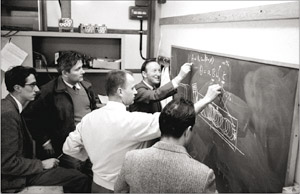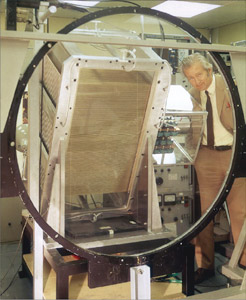An interview with Georges Charpak as he turns 85.
Physicist Georges Charpak joined CERN 50 years ago on 1 May 1959. He retired from the organization in 1991 and now lives in Paris, where he studied and worked for the CNRS before coming to CERN. In August 2008 I visited him (with a cameraman and photographer) at his apartment in rue Pierre et Marie Curie. There is perhaps no better address for a physicist who developed detection techniques that have not only allowed a deeper study of the structure of matter but also found important applications in medicine and other fields. This work led to his Nobel Prize in 1992.
The photo session was to complete CERN’s Accelerating Nobels exhibition with photographs by Volker Steger, which was one of the features of the LHC inauguration. As we entered Charpak’s chaotic but charming office, he made jokes about his Nobel Prize: “Ca devait être une année creuse” (“It must have been a slack year”) for the Nobel Committee. Then he patiently accepted Steger’s request to make a drawing of his discovery with coloured pens on a big sheet of white paper, and finally to sit for the photo session.

Image credit: M Struik.
The caption that he added to his drawing of a wire chamber is a good summary of the value that his contribution made to particle physics: “D’un fil isolé à des centaines de milliers de fils independents” (“From an isolated wire to hundreds of thousands of independent wires”). As Charpak explains in his latest book (Mémoires d’un Déraciné, Physicien, Citoyen du Monde), in 1968 his first 10 × 10 cm2 proportional multiwire chamber “was perfectly capable of detecting in an independent way, and on each of the wires, separated by a millimetre, the pulses produced by the nearby passage of an ionizing particle. In this way we could fill the space with thousands or hundreds of thousands of wires to visualize the trajectory of charged particles”.
This was an experimental technique that many others had attempted but had until then produced catastrophic results, ending in the destruction of “a thousand dollars’ worth of amplifiers”. What was missing was an understanding of the formation of pulses in a proportional multiwire chamber. Charpak realized that they were produced by the movement of positive ions, which induced pulses of opposite polarity near the wires. This approach to solving experimental problems, through an in-depth study of the phenomena involved, reveals the theoretical physicist’s spirit in Charpak. His secret dream, as he confesses in his book, has always been to be a theoretician.
You had a long career in experimental physics. Which result are you most proud of?
It was my first experiment, with Richard Garwin and Leon Lederman (five scientists signed the paper), and CERN’s first large experiment at the time: g-2. That was an extraordinarily elegant experiment. At last, we had contributed to measuring the magnetic moment of the muon to some 10 decimal places, and that was a real tour de force.
Then, of course, came our research on wire chambers, which were very small and became huge – with large groups making all sorts of experiments, also with cosmic rays. They were incredibly successful. The teams using wire chambers in medical applications are very small – I like teams where I can keep human contact with people and where I can minimize bureaucracy.
The wire chambers led to the Nobel Prize in Physics. What did this bring to you?
Free coffee whenever I entered a bar, a lot of visibility in the streets of Paris because of the television – people still stop me to express their admiration – a lot of travelling and even a dozen pairs of shoes that were offered by fans.
What would your advice be to a young physicist who would like to receive the Nobel prize?
If I were a young experimentalist, I would do experimental physics with cosmic rays because they enable you to reach much higher energies than at the LHC, even if you have to build a 1 × 1 km2 or 10 × 10 km2 detector, and even if there’s only one good event per year – that one event will bring something extraordinary. Then I think that sooner or later physics will need very good thinkers – theoreticians who are able to imagine new things. Theoretical physicists have an important role to play, provided that they do not become dictators. I understand the excitement that they get from the prospects in high-energy physics today. I think physics is experiencing a rejuvenation.

After your research work at CERN, you devoted your time to the industrial applications of detectors. Tell us about that.
I do not have the gifts to be a department – or even group – leader. I’ve never been anything like that outside my own group. I’m very unorganized and I hate hierarchies. Very quickly my small detectors were used inside big detectors, but when I saw groups with more than 1000 physicists I became scared. So I decided to switch to the application of my detectors to medicine and biology. I have had some success in radiology for children – the best instrument available is still the one that I proposed.
Another question is to see whether it will sell, or flood hospitals because it is the best, but this unfortunately is a commercial question. Physicists are not necessarily businessmen. You can have as many Nobel Prizes as you want, but once you go out to industry it’s a completely different story. I go to many conferences on children’s diseases, I make presentations about the instruments I make, but the difficulty is in introducing these new instruments to hospitals. You need the approval of the US Food and Drug Administration and the agreement of insurers to reimburse, and this is not my competence. But I am not ruined yet and I’ll go on.

What are you busy with at the moment?
I am annoyed because I lost part of my autonomy after a small accident. I survive. I continue doing some physics – that’s the easiest – and I am working on a book to teach nuclear physics to children. I took out a patent three months ago, and built a detector 50 times less expensive than a standard one. I hope to be able to offer cultivated people the possibility of buying a book for their children that is written by very good physicists (I did not do it all by myself). I have proposed building instruments that make measuring radioactivity a very trivial thing. So I am working in education.
For the last 12 years I have been involved with a huge educational project, La Main à la Pâte, which certainly is my most important contribution to society – schools in the Amazon basin practise La Main à la Pâte. This new educational method based on learning science through direct experiment is becoming more and more popular. We need a revolution in science education because we live in a world where obscurantism has too big a role, for my taste, and this is my personal fight against obscurantism in collaboration with people from around the world. I received a prize for it in Mexico together with Leon Lederman, which was a very pleasant surprise for me. It indicated that what we do in France with children has reached such a level, that even in a place as monopolized by the US as Mexico is, our work is recognized.
CERN’s immediate future lies with the LHC. What discoveries do you expect?
We expect the unknown – to see things that are not necessarily foreseen by theory. Because there are still mysteries in physics – dark matter, for example – there are answers from theoreticians and there are many questions from experimentalists like myself. If theory were completely accurate we would not need to build an accelerator.
The LHC might bring unexpected results, and the fact that we have a suspicion about the existence of a form of matter that is not the same as the one that makes up the known universe is very exciting. Personally, I find it very amusing to expect new matter. Is it true or false? If it’s false it’s a myth, and maybe some people will have to give back their Nobel medals because they will have foreseen false entities. But if it is true, it is very exciting because there are still extraordinary things to discover in the universe. Young people who enter the field now are lucky that this physics is not completed.
• For a longer video version of this interview in French, visit http://cdsweb.cern.ch/record/1138212.





